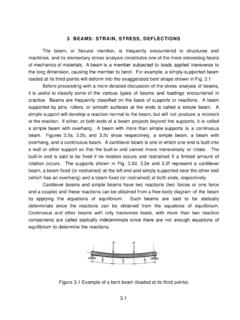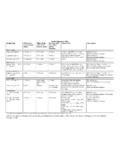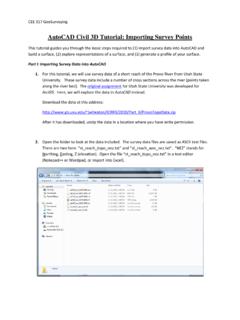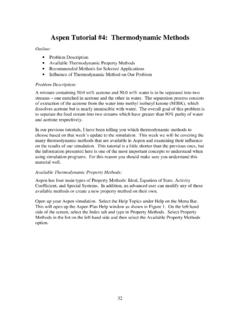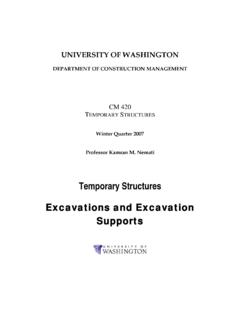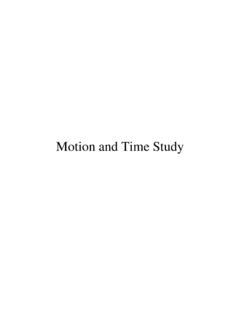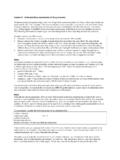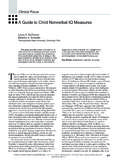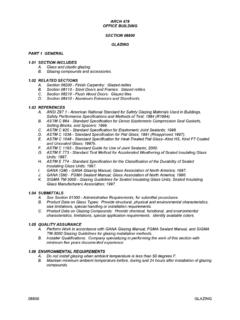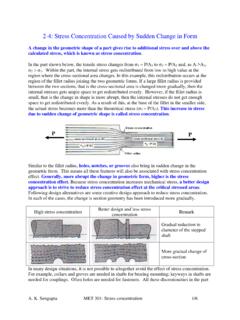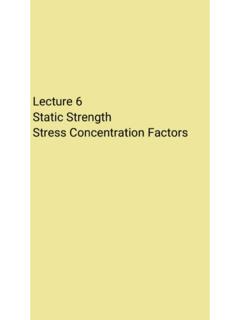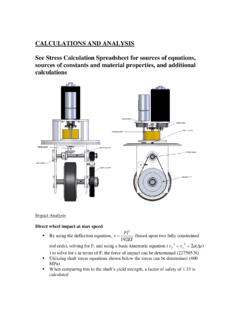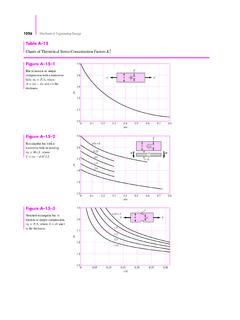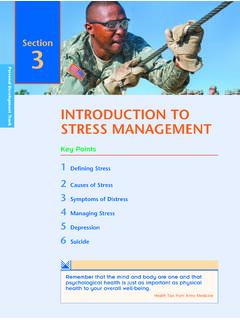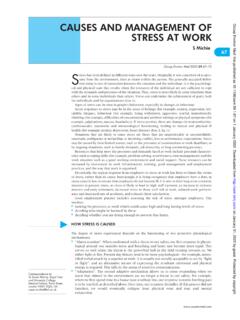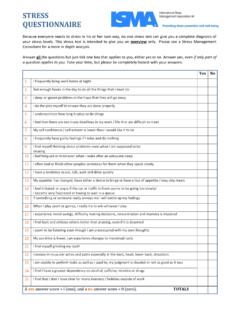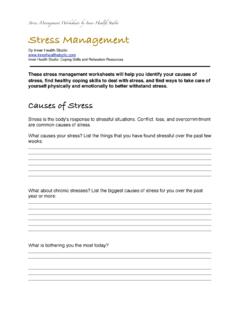Transcription of Stress Concentrations - University of Washington
1 Prof. M. E. Tuttle University of WashingtonStress Concentrations A Stress concentration refers to an area in a object where Stress increases over a very short distance ( , where a high Stress gradient exists) Stress Concentrations typically occur due to some localized change in geometry (near holes, filets, corners, grooves, cracks, etc) These changes in geometry are often called Stress risers Prof. M. E. Tuttle University of WashingtonStress Concentration Near a Circular Hole In 1898 Ernst Kirsch (a German engineer) published a solution for the elastic stresses near a circular hole in an isotropic infinitely large thin plate (the Kirsch solution is derived in Sec of the Shukla and Dally textbook) In practice, a thin plate can be considered to be infinitely large if the hole diameter is small compared to the in-plane plate dimensions (if a/D< ~ , say)D2aooProf.
2 M. E. Tuttle University of WashingtonStress Concentration Near a Circular Hole Stresses along the x-axis in an infinite plate predicted by the Kirsch solution:032231244222322== ++== ==xyroyyoxxrrxaxaxaxa Figure : Distribution of xx/ oand yy/ oalong the x-axisProf. M. E. Tuttle University of WashingtonStress Concentration Near a Circular Hole Stresses at the edge of the hole (at x = a): The Stress concentration factor for a circular hole inan infinite plate:030======xyroyyxxrr Figure : Distribution of xx/ oand yy/ oalong the x-axis3==oyytK Prof. M. E. Tuttle University of WashingtonStress Concentration Near a Circular Hole If a/D> then the plate is finite and the Kirsch solution is no longer valid Stress concentration factors for a circular holes infinite plates have been measuredexperimentally for a range of a/Dratios (usually usingphotoelasticity), and tabulated inthe form of curve-fits in reference handbooks.
3 Required several yearsand many contributorsDoo2aProf. M. E. Tuttle University of WashingtonStress Concentration Near a Circular Hole Example: Wahl, , and Beeuwkes, R., Stress Concentration Produced by Holes and Notches , Transaction of the ASME; Applied Mechanics, Vol 56 (11) , 1930 Prof. M. E. Tuttle University of WashingtonStress Concentration Near a Circular Hole Two different definitions of the Stress concentration factors arein common use:-based on the grossstress :( gremains constant as aincreases)-based on the netstress:( nincreases as aincreases)DtPKggyygt* wheremax== )2(* re whemaxaDtPKnnyynt == 2aDPPProf. M. E. Tuttle University of WashingtonStress Concentration Near a Circular Hole Example: from Roark s Formulas for Stress and Strain (2002) + =DaDaDaKntProf.
4 M. E. Tuttle University of WashingtonTabulated Stress Concentration Factors Stress concentration factors for many types of Stress risers have been example:-Young, , and Budynas, , Roark s Formulas for Stress and Strain, 7thedition, McGraw-Hill, (2002) - online tabulations: M. E. Tuttle University of WashingtonStress Concentration Near an Elliptical Hole In 1913 Charles Inglis (a British mathematician) published a solution for the elastic stresses near an elliptical hole in an isotropic infinitely large thin plate (the Inglis solution is discussed in Sec ) In this case the Stress concentration depends on both the aspect ratio of the hole (a/b) and on the size of the plateProf. M. E. Tuttle University of WashingtonStress Concentration Near an Elliptical Hole For an infinite plate the stresses along the x-axis ( , for x a, y= 0) are given by:where:0)()()()(2)(1)(2)(1=+= =xFFxFFxxyssyyssxx babambaBmBxBxsmsmsmsmmsmFmsmFss+ =+= += + += ++= )(21 22311112 )1(212222222)(22)(1 Prof.
5 M. E. Tuttle University of WashingtonStress Concentration Near an Elliptical Hole For a finite plate: + =+ = =++= + + +=Prof. M. E. Tuttle University of WashingtonMeasuring Stress Concentrations Using Strain Gages In general, even the smallest of commercial resistance strain gages are too large to measure strain Concentrations near Stress risers:Prof. M. E. Tuttle University of WashingtonMeasuring Stress Concentrations Using Strain GagesProf. M. E. Tuttle University of WashingtonMeasuring Stress Concentrations Using Strain Gages In general, even the smallest of commercial resistance strain gages are too large to measure strain Concentrations near Stress risers:..a poor experimental approachooProf. M. E. Tuttle University of WashingtonMeasuring Stress Concentrations Using Strain Gages Instead, use a commercial strip gage and extrapolate experimental measurements to edge of Stress riserProf.
6 M. E. Tuttle University of WashingtonPseudo Lab #6: Stress and Strain ConcentrationsProf. M. E. Tuttle University of WashingtonPseudo Lab #6: Stress and Strain in(typical)12345678910 Axial gagesM-M gage type SA-13-031PJ-120 Gage factor = , Kt = in(typical)12345678910 Transverse gagesM-M gage type EA-13-031MF-120 Gage factor = , Kt = M. E. Tuttle University of WashingtonCorrections for Biaxial Rosettes With Differing Transverse Sensitivity CoefficientsytxtmyxtytomxxtoxKKKKK =1)1()1( ytxtmxytxtomyytoyKKKKK =1)1()1( =mymx ,strains measured in the x- and y- directions=ytxtKK,Transverse sensitivity coefficients for gages in the x- and y- directionsMM Tech-Note 509 Errors Due to Transverse Sensitivity in Strain Gages Prof. M. E. Tuttle University of WashingtonPseudo Lab #6: Stress and Strain ConcentrationsGoals: To compare Stress distributions measured near an elliptical hole in a finite thin plate to those predicted for an infinite thin plate, and To compare the Stress concentration factor measured for an elliptical hole in a finite thin plate to the value expected from a reference M.
7 E. Tuttle University of WashingtonPseudo Lab #6: Stress and Strain Concentrations Official Data Axial Strains-20002004006008001000120005001000 150020002500300035004000 Strain ( )Applied Load (lbf)Axial StrainsGage 1 AGage 2 AGage 3 AGage 4 AGage 5 AGage 6 AGage 7 AGage 8 AGage 9 AGage 10 AProf. M. E. Tuttle University of WashingtonPseudo Lab #6: Stress and Strain Concentrations Official Data Transverse Strains-80-60-40-20020406005001000150020 002500300035004000 Strain ( )Applied Load (lbf)Transverse StrainsGage 1 TGage 2 TGage 3 TGage 4 TGage 5 TGage 6 TGage 7 TGage 8 TGage 9 TGage 10 TProf. M. E. Tuttle University of WashingtonPseudo Lab #6: Stress and Strain ConcentrationsGoal 1: Compare Stress distributions measured near an elliptical hole in a finite thin plate to those predicted for an infinite thin plate(Suggestion: compare normalized stresses) yy/ netPosition along x-axis (in)Inglis SolutionMeasuredNote: as mentioned during class lecture, the measured values shown here are fictitiousProf.
8 M. E. Tuttle University of WashingtonPseudo Lab #6: Stress and Strain ConcentrationsGoal 2: To compare the Stress concentration factor measured for an elliptical hole in a finite thin plate to the value expected from a reference handbook.(Suggestion: extrapolate a curve fit) axial Stress Prof. M. E. Tuttle University of WashingtonPseudo Lab #6: Stress and Strain ConcentrationsGoal 2: To compare the Stress concentration factor measured for an elliptical hole in a finite thin plate to the value expected from a reference of fictitious data using a 2nd-order polynomial:y = + axial Stress Prof. M. E. Tuttle University of WashingtonPseudo Lab #6: Stress and Strain ConcentrationsGoal 2: To compare the Stress concentration factor measured for an elliptical hole in a finite thin plate to the value expected from a reference of fictitious data using an exponential:y = axial Stress Prof.
9 M. E. Tuttle University of WashingtonPseudo Lab #6: Stress and Strain ConcentrationsGoal 2: To compare the Stress concentration factor measured for an elliptical hole in a finite thin plate to the value expected from a reference of fictitious data using a power lawy = Axial StressProf. M. E. Tuttle University of WashingtonPseudo Lab #6: Stress and Strain ConcentrationsGoal 2: To compare the Stress concentration factor measured for an elliptical hole in a finite thin plate to the value expected from a reference of fictitious data using an polynomial and (1/normalized Stress )y = + - Axial Stress
